Richard Foster immerses himself in Noordwijk’s world of weekend bikers, expensive dog owners, German families, local beach bums — and rumours of lorry-jacking.
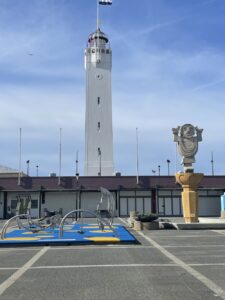
Mensen zien er echt ongelukkig uit in Noordwijk.
From the vantage point of the cosy terrace of Noordwijk’s Koffiehuis, this remark, overheard from a couple of well-to-do women having lunch on a neighbouring terrace, struck a jarring note. By contrast, De Koffiehuis is a bubble of wellbeing: we were having a lovely time, basking in some unexpected spring sunshine. One can sit on the old wooden seats bordering its large, raised front window and watch Noordwijk’s world — weekend bikers, expensive dog owners, German families and local beach bums — go by.
The bar where the women sat was a new venture in a refurbished space, like so many places, currently, in this popular seaside resort. It was still early but the joint was sparsely populated. Waiters stood around bored, taking turns to attend to the few customers. A pair of lava lamps throbbed dully at the entrance, lighting a chilly-looking interior.
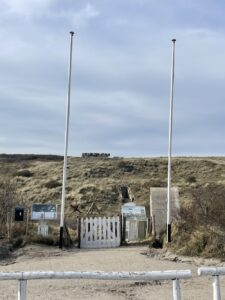
Noordwijk always feels like a place of perpetual, if never fully realised opportunity: akin to an old gold rush town where the developers are still trying to keep up with the new townsfolk’s ambitions. Its beautiful dunes and beaches play host to some of the swankiest real estate and hotels in the country, as well as some glorious beaches. According to some sources, the land price in Noordwijk amounts to one thousand euros per square metre. But the old fishing village’s centre and seafront display a puzzling clutter of architectural styles that speak of anything but a well-to-do settlement. The old civic ambition that took the form of low-level brutalism and kiss-me-kwik clapboard jollity is being steadily knocked down, but what follows?
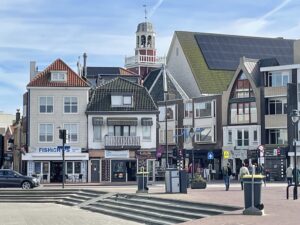
For now, in this latest period of becoming for the town, everything feels slightly misplaced. A plethora of fashion and beachwear shops and the many, varied cafes sit near building lots. On the north dunes, just out of town, a Dutch resistance museum, and a museum dedicated to the German Atlantic Wall eye each other up. Around the town, the worlds of crazy golf and wellness rub uncomfortably alongside each other. Muzak piped from speakers on the lampposts greets shoppers on the old village high street. The shiny start-ups and increasingly dogeared favourites, by their very proximity, speak of the transience of time in this town. The modest local museum and lifeboat centre, alongside the musty-but-lovely tabac shop and the ancient wooden barrow selling herrings aan het staart near the seafront, give some anchor points for civic continuity. But unlike Katwijk there is no real sense of an overriding local purpose. The only constant structure over time will probably be the statue of Queen Wilhelmina, the revered matriarch, who stares doggedly inland, over the boulevard named after her.
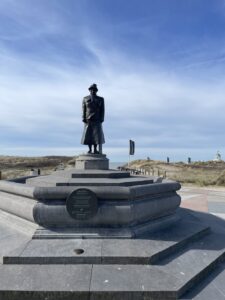
Like many rich and constantly changing places, Noordwijk has had its fair share of controversy. It is a place where — if you were to believe some — you can readily buy weapons and other things under the counter. Noordwijk’s pubs are friendly but can be feisty: the now disappeared Happy Bar, situated some streets off the seafront was, in the memory of this writer, the most misnamed pub in history. But people went and drank there, regardless. Rumours of lorry-jacking at gunpoint, or bombs thrown through doors also circulate. The victim of one of the country’s most famous kidnappings, Freddy Heineken, lived in De Ark, one of a complex of five elongated, one-floor villas covering 20,000 square metres of Noordwijk land. De Ark, and the villas De Duif, De Regenboog, De Raaf and De Ararat are built in the American farmhouse style that Heineken loved. De Regenboog also has an atomic fallout shelter dug deep under its garden. When Heineken and his driver Ab Doderer were kidnapped in Amsterdam on November 9, 1983, De Ark became the command centre for the police hunting the kidnappers.
One of the more surprising aspects of Noordwijk is that a great deal of good underground music has originated from here over the last few decades. Local metalheads, punks, poets and wannabe pop stars have made their mark in the amorphous set of scenes that were termed the Dutch Underground in the mid-to-late noughties. The great alternative poet and musician Marc van der Holst is one of those; a man whose wry and funny observations could also once be read in left-liberal national paper de Volkskrant. Van der Holst is rightly celebrated for his highly sardonic alt-folk, and his long-running — if bizarre — cartoon series narrating the adventures of a piglet, Spekkie Big. Others include the WOTNXT foundation, a group who shaped a great deal of the region’s musical palette in the late nineties and noughties, taking advantage of the still-extant squats and “grey spaces” in Leiden and surrounds, to put on a dizzying array of underground techno, metal and punk shows. There are a lot of surprisingly radical enclaves around here, still; if maybe not as loud, or public-facing as they once were. On the road to Noordwijkerhout, a complex boasting renovated old wooden farmer’s houses and a glass, pyramid-like structure was an intermittent host for wild nights of alternative music and prose. These things radiate long in the memory.
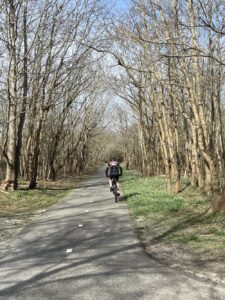
Noordwijk’s true glory lies in the countryside around it. The raised grounds of the dunes sometimes reveal spectacular views over the flower fields in spring. A cycle around the Boswachterij to the north, or the Coepelduynen, the stretch between Katwijk and Noordwijk to the south, are full of hidden treasures; the dips and undulations of the dunes that have collapsed over time — termed dune slacks — host a widely varying set of ecosystems; a mix of dune grasslands, marshy hollows and mixed woodland. Pyramidal and fen orchids grow here. You can see toads, newts, sand lizards and many dragonflies, as well as stonechats (ten percent of the Dutch population of stonechats breed around the town’s dunes) and — if you’re really lucky — turtle doves. You will probably hear nightingales in the heat of a summer midday. Goshawks have been known to patrol the area and bordering the town, your correspondent once saw ravens in the municipal cemetery. Concerted attempts are being made to keep the habitats alive by keeping them dynamic, rolling entities; by managing the spread of trees and exotic shrubs and grasses, and, maybe, by eventually combatting the nitrogen pollution from the intensive bulb farming that occurs here.
Maybe the town, with its constant architectural pruning, is merely taking note of what the dunes have long tried to tell it.
*
Richard Foster is an artist and writer. He runs the Museum of Photocopies.